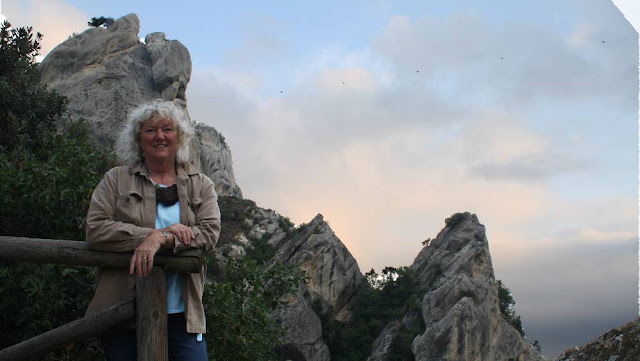Italian hilltop and
hillside villages are among my favorite things in life, and I’ve found a pearl
in Castelmezzano, a village perched on the side of the rugged Dolomiti Lucane
in Basilicata. It’s been described in tourist brochures as a “small nativity
scene suspended in time and nature.”
The rock formations above and around the village are fascinating in shape, size and texture, and it’s a superb location for trekking on mountain trails or for rock climbing. Two of the top three attractions are hiking trails (the Volo dell’Angelo is number 1), and the fourth is the Salemm via ferrata—iron path—which is a protected climbing route with preset pitons and steel cables. Two members of our traveling party have done all the top three. Lucy and I passed on number 3, a strenuous four-hour hike from Castelmezzano to Pietrapertosa and back called the Le Sette Pietre, but Dave and Wendy toughed it out.
 |
| Delirium |
We did attraction number 2 yesterday, the Gradinata Normanna, a scenic climb into the rocks above the town to experience the morning sunrise. While dark clouds prevented a more spectacular view toward the eastern horizon, we still enjoyed great views of the valleys and both Castelmezzano and Pietrapertosa. Huge rocks jutted up severely, and wind and water erosion created some unusual textures that reminded me of drawings I’ve seen of diseased alveoli cross sections (in human lungs).
However, the most evocative attraction on the hike was
the gradinata itself—the Norman staircase, an extraordinary work of which has
to be seen to be appreciated. Somehow laborers carved a staircase into an
incredibly large boulder that juts into the sky. It’s hard to imagine the bravery
it would have taken to build the staircase and then ascend it to serve guard
duty.
 |
| Only the bravest of warriors would attempt this climb, and here is one of them. |
The entrance is blocked off, though Dave, obviously
the most fearless member of our travel group, did his best to bypass the locked
gate. I’m sure he would have been able to reach the top had he only been able
to reach the lower steps. Much to everyone’s relief (especially Dave’s), he was
not able to access the gradinata starting point. And if you don’t realize it
yet, he was only fooling around so we could take a photo of him pretending to be
eager to climb to the top. He has a penchant for setting up goofy photos at scenic
viewpoints.
 |
| Dave also attempted the via ferrata without any gear. |
The town website does say that it is possible to climb to the top at certain times using cables for railings and wearing safety harnesses, but that must be possible only on peak days of the tourist season. We spent an hour taking photos at various viewpoints and did not see another soul.
The town itself, though, should be listed as a top
attraction, as the streets and buildings are stunningly picturesque. While this
in itself is not unusual for Italy, what makes it different from many small
mountain villages is that it is still very lively, with locals sitting outside,
chatting, playing cards or going about their daily business. Many remote Italian
towns have suffered from a drastic reduction in population, and once the people
start leaving, the restaurants, grocery stores and other services shut down.
Not so in Castelmezzano, though, probably because of the trails and ziplines,
and that makes it special—a delightful small village bustling, sparkling and
full of life—a true gem.
 |
| Castelmezzano viewed from the trail above. |








































